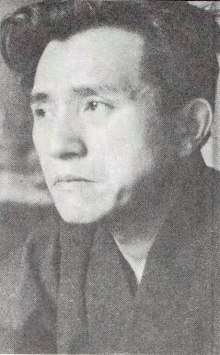Tsutomu Minakami
Tsutomu Mizukami (水上 勉, Mizukami Tsutomu, March 8, 1919 – September 8, 2004), also known as Minakami Tsutomu, was a popular and prolific Japanese author of novels, detective stories, biographies, and plays. He won the Tanizaki Prize and the Naoki Prize, and many of his stories were made into movies.

Biography
Mizukami was born in Wakasa, Fukui Prefecture, to a poor family. Between the ages of 9 and 12, he was a novice in a Zen temple in Kyoto. Disillusioned by the conduct of the temple's chief priest, however, he left the temple in 1936.
Mizukami entered Ritsumeikan University to study Japanese literature, but dropped out for financial reasons and because of bad health. After World War II he learned from author Kōji Uno, and in 1952 wrote the autobiographical Furaipan no uta (Song of the Frying Pan), which became a best-seller. For nearly the next decade, however, he did not publish, but in 1960, his story centering on Minamata disease, Umi no kiba (The Ocean's Fangs), started his career as a writer of detective stories on social themes.
His autobiographic Gan no tera (Temple of the Geese) won the Naoki Prize in 1961, and was adapted for film by Kawashima Yūzō (1962).[1] He followed this in 1962 with Kiga kaikyô (Starvation Straits, 1962) which was made into a film under the same name by Tomu Uchida (A Fugitive from the Past, 1965), and Kiri to kage (Fog and Shadows, 1963), then novels dealing with women's concerns, including Gobanchô Yûgiri-rô (The Pavilion of the Evening Mist at Gobanchô, 1963) and Echizen takeningyô (The Bamboo Dolls of Echizen, 1964).
He won the 1975 Tanizaki Prize for Ikkyū (一休), a biography of an eccentric Zen-master Ikkyū.[2]
Recognition
- 1961 45th Naoki Prize (1961上)[1]
- 1975 11th Tanizaki Prize[2]
Selected works
- Oriento no tō : suiri chōhen (オリエント の 塔 : 推理 長篇), Tōkyō : Bungei Shunjū Shinsha, 1962.
- Umi no koto (湖の琴), Tōkyō : Kadokawa bunko, 1966.
- Ryogan no ki (旅雁 の 記), Tōkyō : Daikōsha, 1970.
- Shi no ryuiki, 1972.
- Umi no kiba, 1972.
- Danjiki, 1974.
- Ikkyū (一休), 1975.
- Iteru niwa (凍てる 庭), Tōkyō : Shinchō bunko, 1975.
- Teradomari (A Temple Stay), 1977.
- Nihon meisho fūzoku zue, 19 vols., ed. Ikeda Yasaburō, Noma Kōshin, Mizukami Tsutomu. Tōkyō : Kadokawa Shoten, 1979-1988.
- Katakage no michi : watakushi no Shōwa shi (片陰 の 道 : 私 の 昭和 史), Tōkyō : Gendaishi Shuppankai : Hatsubai Tokuma Shoten, 1979.
- Kinkaku enjô (The Burning of the Golden Pavilion), 1979.
- Mizu no gensō : gendai no zuiso (水 の 幻想 : 現代 の 随想), Tōkyō : Nihon Shoseki, 1979.
- Tengusa O-Mine, 1979.
- Chi no chibusa, Tokyo : Fukutake Shoten, 1981.
- Heike monogatari, Tokyo : Gakushū Kenkyūsha, 1981.
- Hito no koyomi hana no koyomi, Tokyo : Mainichi Shimbunsha, 1981.
- Mizukami Tsutomu ni yoru Mizukami Tsutomu, Tokyo : Seidōsha, 1982.
- Take no seirei (竹 の 精霊), Tōkyō : Shōgakkan, 1982.
- Waga bungaku waga sakuhō : bungaku shugyō sanjūnen, Tōkyō : Chūō Kōronsha, 1982.
- Wakasa shōyō, Tōkyō : Heibonsha, 1982.
- Hataraku koto to ikiru koto, Tōkyō : Tōkyō Shoseki, 1982.
- Heike monogatari shō, Tokyo : Gakushū Kenkyūsha, 1982.
- Kinō no yuki, Tōkyō : Shinchōsha, 1982.
- Kyōto henreki, Tōkyō : Heibonsha, 1982.
- Mizukami Tsutomu Bukkyō bunshū, Tōkyō : Chikuma Shobō, 1982.
- Mizukami Tsutomu kikō bunshū, 8 vols., Tōkyō : Heibonsha, 1982-1983.
- Sengoku kassenzu (戦国 合戦図), Ōsaka-shi : Hoikusha, 1983.
- Shōsetsu no butai saihō, Tōkyō : Heibonsha, 1983.
- Tabi no shōsetsushū, Tōkyō : Heibonsha, 1983.
- Waga onna hito no ki, Tōkyō : Heibonsha, 1983.
- Chūgoku e no tabi, Tōkyō : Heibonsha, 1983.
- "Hannya shingyō" o yomu, Kyōto : PHP Kenkyūjo, 1983.
- Ichie no hitobito, Tōkyō : Heibonsha, 1983.
- Koji junʾyū, Tōkyō : Heibonsha, 1983.
- Mizukami Tsutomu ga kataru Nihon ryōiki, Tōkyō : Heibonsha, 1983.
- Rekishi e no tabi, Tōkyō : Heibonsha, 1983.
- Kyō no omoide zue, Tōkyō : Heibonsha, 1984.
- Toritachi no yoru (鳥たち の 夜), Tōkyō : Shūeisha, 1984.
- Hito no yo wa nasake no kashi kari (人 の 世 は 情け の 貸し 借り), Tōkyō : Shōgakkan, 1984.
- Ishi yo nake (石 よ 哭け), Tōkyō : Komichi Shobō, 1984.
- Juge shōyō (樹下 逍遙), Tōkyō : Asahi Shinbunsha, 1984.
- Haha (母), Tōkyō : Sakuhinsha, 1986.
- Ikiru hi shinu hi (生きる 日 死ぬ 日), Tōkyō : Fukutake Shoten, 1987.
- Koteki (湖笛) Tōkyō : Kōdansha, 1988.
- Zen to wa nani ka : sore wa Daruma kara hajimatta (禪 と は 何 か : それ は 達磨 から 始まった), Tōkyō : Shinchōsha, 1988.
- Haai : Setsumon Genshō no shōgai (破鞋 : 雪門 玄松 の 生涯), Tōkyō : Iwanami Shoten, 1990.
- Inochi no chiisana koe o kike (いのち の 小さな 声 を 聴け), with Haitani Kenjirō, Tōkyō : Shinchōsha, 1990.
- Yama no kure ni (山 の 暮れ に), Tōkyō : Mainichi Shinbunsha, 1990.
- Zaisho no sakura (在所 の 桜), Tōkyō : Rippū Shōbō, 1991.
- Tanizaki Sensei no shokan : aru shuppansha shachō e no tegami o yomu (谷崎 先生 の 書簡 : ある 出版社 社長 へ の 手紙 を 読む), Tōkyō : Chūō Kōronsha, 1991.
- Daigo no sakura (醍醐 の 櫻), Tōkyō : Shinchōsha, 1994.
- Seifuki (清富記), Tōkyō : Shinchōsha, 1995.
- Waga betsuji : michibikareta hibi (わが 別辞 : 導かれた 日々), Tōkyō : Ozawa Shoten, 1995.
- Bundan hōrō (文壇 放浪), Tōkyō : Mainichi Shinbunsha, 1997.
- Utsutake no fue (The Hollow Bamboo Flute), 2002.
References
- "直木賞受賞者一覧" (in Japanese). 日本文学振興会. Retrieved August 15, 2018.
- "谷崎潤一郎賞受賞作品一覧" (in Japanese). Chuokoron-Shinsha. Retrieved August 15, 2018.
External links
| Wikimedia Commons has media related to Mizukami Tsutomu. |